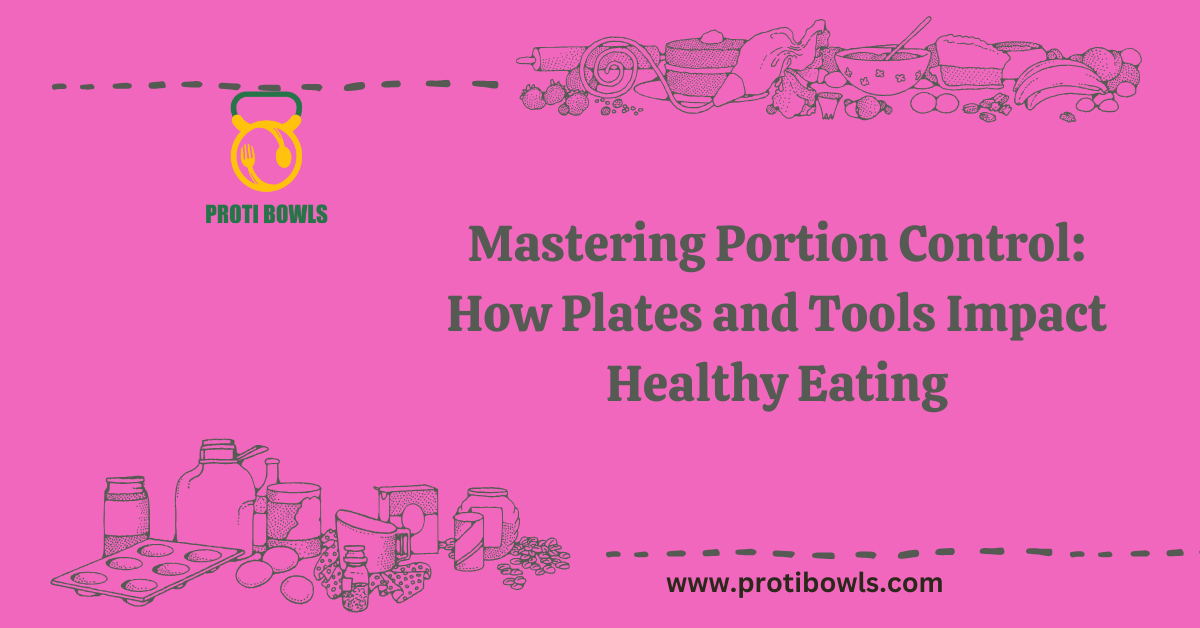


Mastering Portion Control: How Plates and Tools Impact Healthy Eating
Is your portion size silently sabotaging your health goals? In today’s food environment filled with oversized meals and mindless snacking, mastering portion control is more crucial than ever for healthy eating, weight management, and long-term wellness. From the use of a portion control plate to insights from the latest systematic review and meta-analysis, this article covers everything you need to know about how portion control tools affect our eating behavior, body weight, and nutrition awareness.
By the end of this read, you’ll learn how to adjust your serving size, select the appropriate portion control tool, and adopt sustainable habits backed by science. Whether you’re managing obesity, improving a meal plan, or simply becoming more mindful about food, this guide offers actionable steps to help you reach your goals.

Article Outline
- What Is Portion Control and Why Does It Matter?
- The Link Between Portion Size and Weight Management
- How Portion Control Plates Promote Healthy Eating
- The Psychology Behind the Smaller Plate Strategy
- Systematic Review of Portion Control Tools and Their Effectiveness
- Different Portion Control Tools and How to Use Them
- Portion Control for Children and Family Meal Planning
- Addressing the Impact of Large Portion Sizes on Energy Intake
- Common Challenges and How to Improve Portion Control
- Long-Term Strategies and Scientific Insights on Sustainable Eating
1. What Is Portion Control and Why Does It Matter?
Portion control is the practice of managing the amount of food you eat at each meal. Unlike general dieting, which often focuses on food type, portion control addresses portion size—a major contributor to energy intake and body weight.
Research shows that self-selected portion size is often larger than necessary, especially when eating out or during celebrations. As a result, portion control tools, such as visual guides and portion control plates, help people become more mindful of the appropriate portion per meal.
When used consistently, portion control supports healthy eating, helps avoid rapid weight loss swings, and creates a sustainable path toward better health.
2. The Link Between Portion Size and Weight Management
There’s a well-documented association between food portion size and body weight. Larger portions can subconsciously encourage overeating. A systematic review found that increasing portion sizes can lead to higher energy consumption, affecting overall weight status.
The effect of portion size is particularly notable in women. Studies indicate that the portion size effect in women is linked to social and psychological cues, which can override hunger signals.
Adopting the use of portion control as part of a structured meal plan helps individuals achieve weight management without compromising on nutrition or satisfaction. As portion sizes grow in restaurants and home cooking, this becomes a vital strategy for wellness.
3. How Portion Control Plates Promote Healthy Eating
A portion control plate is a powerful visual portion control tool that segments food groups into recommended portion sizes—typically proteins, vegetables, and carbs. This tool simplifies healthy eating by making it easy to identify appropriate portion sizes without measuring cups or scales.
One systematic review and meta-analysis found that the use of portion control plates led to significant improvements in weight control, particularly in people with obesity. Compared with the control group, those using control plates reported better awareness and dietary compliance.
At Proti Bowls, this concept is incorporated into pre-portioned, chef-designed meals to take the guesswork out of healthy eating while delivering flavor and satisfaction.
4. The Psychology Behind the Smaller Plate Strategy
The smaller plate technique is a behavioral hack rooted in psychological research. By using a smaller plate, the same serving size looks more substantial, reducing the chance of over-serving or seeking seconds.
This effect of portion perception was backed by a systematic review that evaluated how plate size influences food intake. The review concluded that people consistently ate less when using smaller plates, even if the actual portion size was unchanged.
This simple, cost-effective strategy, when paired with other portion control tools, can support weight loss and reduce reliance on willpower alone.
5. Systematic Review of Portion Control Tools and Their Effectiveness
Several systematic reviews have explored the impact of portion control tools on dietary behavior. A recent systematic review and meta-analysis published in a reputable nutrition journal concluded that tools like portion control plates, measuring guides, and hand-size comparisons effectively reduced calorie intake and improved dietary adherence.
The review also analyzed control tools on portion size and noted that while effects vary, most interventions using different portion control tools achieved better outcomes than control groups.
The tools marginally induced weight loss in most populations but showed more significant results in those actively seeking weight management support.
6. Different Portion Control Tools and How to Use Them
There are a variety of available portion control aids beyond plates. These include:
- Hand-based guides for serving size estimation
- Three-dimensional portion control models for visual learners
- Digital apps that track portion size and energy density
Each portion control tool helps users visualize and control food intake. The use of portion size estimation tools increases awareness of portion and reduces reliance on memory or guesswork.
People with obesity using portion control tools have reported greater satisfaction with their meal plans, possibly due to reduced decision fatigue and improved portion accuracy.
7. Portion Control for Children and Family Meal Planning
Teaching kids about portion control is key for lifelong healthy habits. However, the appropriate portion for a child differs from that of an adult. A systematic review on portion sizes for children found that oversized serving sizes can lead to early onset of overweight and obesity.
One study even found that serving portion size influences 5-year-old children’s intake behavior. This emphasizes the need for educational tools that guide both children and parents in selecting the recommended portion size.
Family-friendly control plates to promote healthy eating can make mealtime fun and structured, supporting better food choices for all.
8. Addressing the Impact of Large Portion Sizes on Energy Intake
The effect of large portion sizes extends beyond just calories—it also influences how we perceive fullness. A systematic review on the association between food portion size and BMI revealed that large portion sizes are directly linked to increased energy intake and rising BMI levels.
Further studies on portion size on food intake concluded that the portion size effect in women may contribute significantly to gender-specific patterns in weight gain. The energy density and portion size combination compounds the challenge.
Reducing food portion size, especially for high-energy foods, is essential in managing body weight and achieving sustainable weight loss outcomes.
9. Common Challenges and How to Improve Portion Control
Despite the growing availability of portion control plates and tools, several barriers remain:
- Misjudging serving size when eating out
- Emotional or stress-related eating
- Lack of awareness of food portion size
Experts suggest that combining behavioral strategies with tangible tools offers the most success. For example, using a portion control plate for weight alongside a meal plan improves accuracy and consistency.
Moreover, a personalized plan with regular check-ins—especially in weight loss interventions—can aid in weight loss at 3 months and longer durations. Addressing these pain points is key to helping people improve portion control habits.
10. Long-Term Strategies and Scientific Insights on Sustainable Eating
A long-term solution for portion control involves integrating tools, education, and support. Ongoing research and systematic reviews continue to highlight the use of portion control as a promising approach in weight loss interventions and lifestyle medicine.
The control plate for weight loss remains a popular tool due to its simplicity and effectiveness. However, it’s the integration of this with habit formation—like mindful eating, consistent meal plans, and support from dietitians—that ensures sustainable success.
Proti Bowls offers a real-world application of this research by designing portion control meals based on nutrition science, supporting users in their journey toward better health without sacrificing enjoyment.
Key Takeaways
- Portion control is critical for managing body weight, preventing overeating, and promoting healthy eating.
- Using tools like a portion control plate or smaller plate enhances visual awareness of serving sizes.
- Systematic reviews support the effectiveness of portion control tools in various populations.
- Large portion sizes are directly linked to higher calorie intake and increased BMI.
- Families can benefit from teaching kids appropriate portion sizes for children.
- Combining portion control tools with structured meal plans boosts success in weight management.
- Proti Bowls simplifies this by offering pre-portioned, nutritionist-designed meals aligned with science.
- The use of portion control plates has been shown to promote weight loss and support mindful eating.
- Behavioral strategies like the smaller plate technique are easy and low-cost to implement.
- Long-term success depends on education, consistency, and a personalized approach to portion size and nutrition.











